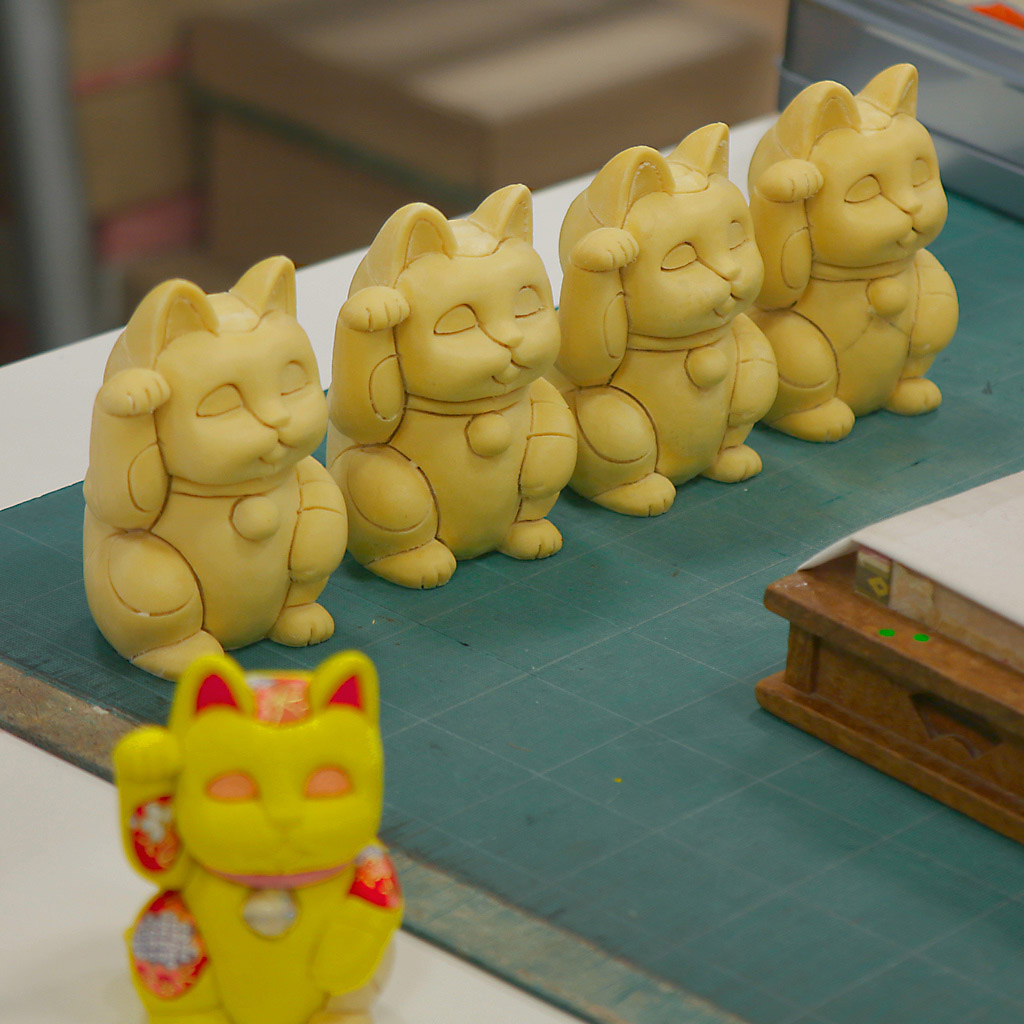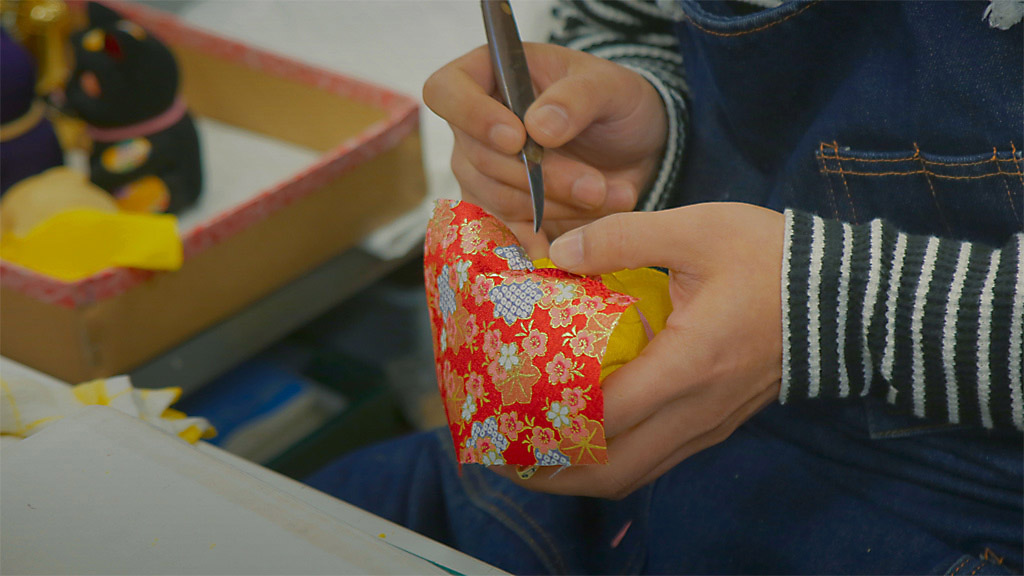[Kimekomi-Ningyo]
木目込人形
木目込(きめこみ)人形の歴史は、江戸時代中期に、京都上賀茂神社の神官に仕える高橋忠重が奉納箱を作る木の残片で作ったのが始まりといわれています。胴体の木地に筋目を入れ、神官の衣装の端切れを埋め込んだことから、「木目込人形」と呼ばれるようになりました。その技法が京都から江戸に伝わり、江戸文化の繁栄とともに、独自の発展をとげます。明治後期には、木彫りから、桐塑※を型抜きして胴体を作る製法がとられるようになり、多量生産や形態の多様化が可能になり、様々な種類の木目込人形が作られるようになりました。
※桐塑(とうそ)…桐の粉末に糊を混ぜて作った粘土
Kimekomi Dolls
The history of Kimekomi-ningyo, or Kimekomi dolls, stretches back to mid-Edo Period, when it is said that Tadashige Takahashi, a carpenter and craftsman in service of the family of Shinto priests at Kamigamo Shrine in Kyoto, used the remnants of a tree he had used to make an offertory box to fashion a small wooden doll. Takahashi dressed the doll by cutting narrow grooves into the wooden body and tucking scraps of cloth from priest’s clothing into them; the name “kimekomi” literally means “tucked into the wood grooves”. The dolls made their way to Edo (old Tokyo), where the doll making techniques were further refined as Edo culture flourished. In the latter half of the Meiji Period, craftsmen began to use toso, (a resin compound made from a mixture of paulownia sawdust and starch) to fashion the dolls out of a mold instead of carving them out of wood—which made it possible to produce them in large quantities and in different shapes, leading to the wide variety of Kimekomi-ningyo seen today.
木目込人形師
柿沼利光
Kimekomi-Ningyo Craftsman
Toshimitsu Kakinuma

| 1950年 | 人形師の初代・柿沼東光氏が「柿沼人形」創業。江戸木目込人形による雛飾りや五月人形、風俗人形などの製造を行う。 |
| 1994年 | 2代目・柿沼東光氏が社長に就任。 |
2005年より人形師芹川英子氏に師事、柿沼東光氏と共に工房を支えている。
2016年1月 フランス「メゾン・エ・オブジェ」、2月、ドイツ「アンビエンテ」に招き猫を出品。アンビエンテでは、トレンドセレクションに選出された。
| 1950 | First-generation dollmaker Toko Kakinuma establishes Kakinuma Ningyo, specializing in Edo Kimekomi dolls for Girl’s Day (Hina-ningyo) and Boy’s Day (Gogatsu-ningyo), and costumed based on historical figures (Fuzoku-ningyo) |
| 1994 | Second-generation Toko Kakinuma assumes the position of CEO. |
| 2005 | Becomes a disciple of dollmaker Eiko Serikawa while working alongside Toko Kakinuma at the Kakinuma Ningyo atelier. |
Submitted maneki-neko (beckoning cat) dolls to French trade show Maison & Objet in January, and German trade show Ambiente in March. Selected as an Ambiente Trend 2016.


インタビュー
経済産業大臣指定伝統的工芸品に指定されている江戸木目込人形。江戸木目込人形師・柿沼東光氏を父にもつ柿沼利光さんは、お兄さんとともに、柿沼人形を支えています。木目込み作業に従事する傍ら、力を入れているのが新商品の開発です。中でも、今、多方面から注目を浴びているのが、愛らしい招き猫。「木目込人形の特徴であるぽってりとした形が猫にマッチしました。普段、節句人形などに使う西陣織や絹だけでなく、レザーやエナメル素材も取り入れています」と柿沼さん。大きな瞳に天然石を使うなどパワーを宿した縁起物は、ラッキーキャットとして人気を博し、ヨーロッパにも進出。ドイツの見本市では、トレンドセレクションに選出されました。
「招き猫が福を運んでくれたのかもしれません(笑)。雛人形の場合、木目込人形は工程別に20~30人の職人が関わるほど、手間暇かけて作られるもの。この招き猫をきっかけに、魅力を知ってもらえたらうれしいですね」。


Interview
Edo Kimekomi-ningyo are designated as a Traditional Craft by the Minister of Economy, Trade and Industry. Toshimitsu Kakinuma and his older brother of Kakinuma Ningyo represent the next generation of dollmakers. They carry on the tradition passed down to them from their father, Kimekomi-ningyo dollmaker Toko Kakinuma, while developing new products and ideas for their craft. Currently the one to watch is their adorable maneki-neko. “The round, plump look of Kimekomi-ningyo was a perfect match for the beckoning cat. In addition to the Nishijin fabric (a traditional brocade produced in Kyoto used for kimono and other accessories) and silk that we usually use on dolls for seasonal festivals, we also use leather and enamel,” says Kakinuma. With natural stones for eyes and an aura of positive energy, these good luck cats were destined to be welcomed with open arms; they are currently also available in Europe. At the Ambiente trade show in Germany, they were selected as an Ambiente Trend 2016 product. “I think we have the cat to thank for all of this good fortune (laughs). Anywhere between 20 to 30 craftsmen are involved throughout the process for making the dolls for Girl’s Day. Hopefully these beckoning cats can serve as an introduction to the beauty of our tradition.”



柿沼人形
Kakinuma Ningyo

店舗情報 / Shop Information :
住所:埼玉県越谷市七左町2-174-4
Adress:2-174-4, Shichiza-cho, Koshigaya-shi, Saitama
電話番号 / Telephone:
048-964-7877
営業時間 : 10:00~18:00
(店舗営業は11月中旬~4月中旬迄)
Hours of Operation:10:00~18:00
(Only between the middle of November and the middle of April)
定休日 : 無休
(年末年始、2/末~3/3は除く)
Closed:Varies
(Closed for year-end and New Year holidays, and between the end of February until 3/3)
ホームページ / Website:
http://www.kakinuma-ningyo.com/![]()








